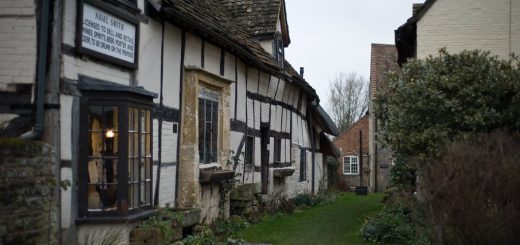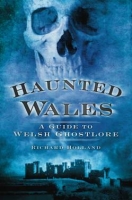Featherstone Castle
The Grade I listed Featherstone Castle is a large country house not far from Hadrian’s Wall. A murdered bridal party is said to haunt the castle on the anniversary of the wedding date, though this is more of a traditional story rather than a reported and witness supported experience. Featherstone Castle is the ancestral home of the Featherstonehaugh family and it comprises of a Jacobean manor built around a peel tower. The family is thought to have been there since the Norman Conquest, though the Featherstonehaugh’s were I believe Saxons and remained at Featherstone for at least twelve generations through Helias de Ffederstanhaugh during the reign of King John to Abigail Fetherstonhaugh in the 17th century. The peel tower was added to Featherstone Castle by Thomas de Featherstonehaugh around 1330, prior to this it was probably best described as a strong Norman farm.
![Craig Wyzik from Olympia, WA, USA [CC BY 2.0 (https://creativecommons.org/licenses/by/2.0)], via Wikimedia Commons](http://www.mysteriousbritain.co.uk/wp/wp-content/uploads/2018/12/1280px-Featherstone_Castle_3-300x225.jpg) As mentioned above the last of the original Featherstonehaugh family to live at Featherstone was Abigail Fetherstonhaugh (born 1627) the heir of Albany Fetherstonhaugh III and she was known to have married twice, first to Peter Dodshon of Kirkby Overblows in Yorkshire and later to Thomas Dykes of Gilcruce in Cumberland. It is recorded that in 1663 she was assessed for County Taxes and she was still alive in 1678. At some point between these tow dates Featherstone Castle was either sold or according to some accounts seized by the State and it passed into the hands of Sir William Howard of Naworth, father of Charles Howard, 1st Earl of Carlisle (born 1629 – died 24 February 1685). During this time period the house was significantly remodelled and enlarged.
As mentioned above the last of the original Featherstonehaugh family to live at Featherstone was Abigail Fetherstonhaugh (born 1627) the heir of Albany Fetherstonhaugh III and she was known to have married twice, first to Peter Dodshon of Kirkby Overblows in Yorkshire and later to Thomas Dykes of Gilcruce in Cumberland. It is recorded that in 1663 she was assessed for County Taxes and she was still alive in 1678. At some point between these tow dates Featherstone Castle was either sold or according to some accounts seized by the State and it passed into the hands of Sir William Howard of Naworth, father of Charles Howard, 1st Earl of Carlisle (born 1629 – died 24 February 1685). During this time period the house was significantly remodelled and enlarged.
Featherstone Castle was sold to Sir Matthew Fetherstonehaugh of Newcastle on Tyne (born 1662- died 1762) in 1711. In 1789 it was sold again and purchased by James Wallace MP (born 1729 – died 1783) and passed to his son Thomas Wallace, 1st Baron Wallace (born 1768 – died 23 February 1844). Again during the time the Wallace owned Featherstone it was remodelled. In 1814 Baron Wallace was married to Jane, daughter of John Hope, 2nd Earl of Hopetoun and Fetherstone Castle eventually passed to Wallace’s nephew, Colonel James Hope who then changed his surname to Hope-Wallace.
Following the start of World War I, Featherstone Castle was leased to an Alnmouth preporatory school and during World War II it was used by a school from Rugby. From 1942 a Prisoner of War camp was based there.
In 1961 Featherstone Castle was bought by Mr John Clark and his father, the great great grandson of the castles land agent circa 1847. Featherstone Castle is now used as a self catering residential centre for young people and students.
Ghost Tradition
The story of the haunting of Featherstone Castle is old and has been written about many times with elements omitted and added over time. The basic story is that a medieval Baron of Featherstone Castle arranged a marriage between his daughter and a man she did not love, he being another noble of equal standing or sometimes referred to as a distant relative. The daughter tried to avoid the wedding as best she could but eventually went through with the ceremony. Whilst awaiting the wedding banquet to be prepared, the Baron sends the married couple, guests and relevant staff out hunting. When the hunting party reached the dense wooded area known as Pinkyn Cleugh they were ambushed by the new bride’s lover and his men-at-arms who attacked in hope of stealing her away from her unwanted husband. The wedding guests and staff fought back and it was a terrible fight where everybody on both sides died. During the fight the bride flung herself in front of her lover as her husband lunged with his weapon and she died of the mortal wound she received. The lover, being the last man standing was so devastated with the loss of the young woman that he stabbed his own heart and died holding her.
Meanwhile, back at Featherstone Castle (which would have been little more than a peel tower then), the Baron awaited their return. After many hours he sent out servants looking for the hunting/wedding party but to no avail. Late in the evening as the Baron was sat asleep in his great hall, the wedding party returned, riding through the main gates and making their way to their allotted banquet places. As the Baron awoke sometime after midnight he was greeted by the ghosts of his guests, clearly showing the wounds that had been inflicted upon them and the distress on their faces, before they faded away. Tradition has it that on the anniversary of the wedding, the ghostly wedding party are said to be seen riding from Pinkyn Cleugh to Featherstone Castle or according to some accounts they appear in the banquet hall re-enacting their ghostly wedding feast.
Another gruesome part of the story is the Raven Stone which is said to still remain near the castle. This cup stone is said to have held some of the blood of the lover after he killed himself and ravens are said to have come down and drank the blood, probably whilst feeding on the corpses lying around.
The key characters in the story are often named when you read about this haunting. The bride is named as being Abigail Featherstonehaugh, whom we know was the last of the Featherstonehaugh family at Featherstone Castle. However, she married twice and reached the age of 50 at least.
The groom is usually named as being Timothy Featherstonehaugh and referred to as being a distant relative of Abigail. There was actually a famous Timothy Featherstonehaugh who was a staunch Royalist and was beheaded by Cromwell in Chester during 1651. Following this his estates were seized and his widow Dame Bridget Featherstonehaugh had £10,000 plundered from her. A memorial for Timothy is in the church at Kirk-Oswald.
The date of the wedding and the anniversary of the said haunting is usually recorded as being 17th January.
The lover in the story is usually referred to as being Ridley Hardriding and here we may find some aspect of the story’s origin. On 24th October 1530, Nicolas Fetherstonhaugh was murdered by William Ridley of Unthank and Hugh Ridley of Howden, possibly during a hunting party.
This actual murder inspired Sir Walter Scott’s ‘The Death of Featherstonhaugh’. The Ridley and Featherstonhaugh feuded and where Scott mentions Hardriding Dick he refers to Richard Ridley of Hardriding and as you can see could easily be the inspiration for the fictional character in the ghost tradition named Ridley Hardriding.
‘The Death of Featherstonhaugh’ by Walter Scott
Hoot awa’, lads, hoot awa’
Ha’ ye heard how the Ridleys, and Thirlwalls, and a’,
Ha’ set upon Albany Featherstonhaugh,
And taken his life at the Deadmanshaugh?
There was Williamoteswick,
And Hardriding Dick,
And Hughie of Hawdon, and Will of the Wa’,
I canno tell a’, I canno tell a’,
And mony a mair that the deil may knaw.
The auld man went down, but Nicol, his son,
Ran away afore the fight was begun;
And he run, and he run,
And afore they were done,
There was many a Featherston gat sic a stun,
As never was seen since the world was begun.
I canno tell a’, I canno tell a’;
Some gat a skelp, and some gat a claw;
But they garr’d the Featherstons haud their jaw,
Nichol, and Alick, and a’.
Some gat a hurt, and some gat nane;
Some had harness, and some gat sta’en.
Ane gat a twist o’ the craig;
And gat a bunch o’ the wame;
Symy Haw gat lamed of a leg,
And syne ran wallowing haine.
Hoot! hoot! the auld man’s slain outright!
Lay him now wi’ his face down; – he’s a sorrowful sight.
Janet, thou donot.
I’ll lay my best bonnet,
Thou gets a new gude-man afore it be night.
Hoo away, lads, hoo away,
We’s a’ be hangid if we stay.
Tak’ up the dead man, and lay him anent the bigging.
Here’s the Bailey o’ Haltwhistle,
Wi’ his great bull’s pizzle,
That supp’e up the broo’, and syne —– in the piggin.




Recent Comments